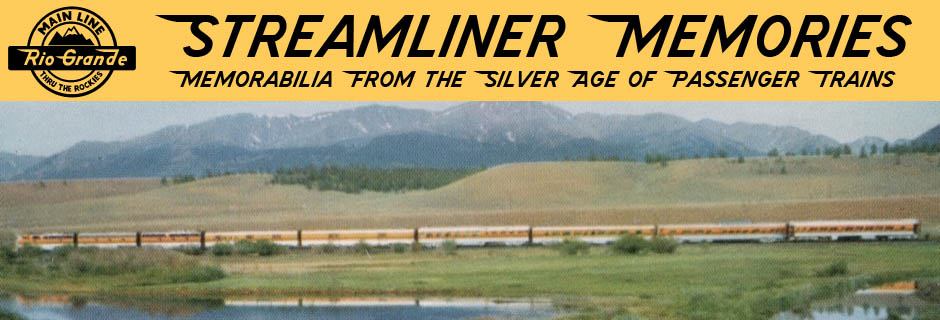No, that’s not an April Fool’s joke: the North Coast Limited really was a Chicago & North Western train for about seven years in the 1910s. This seems peculiar for those used to thinking of the train as a Northern Pacific-Burlington partnership, especially since NP bought nearly half of the stock in the Burlington Railroad a full decade before partnering with the C&NW.
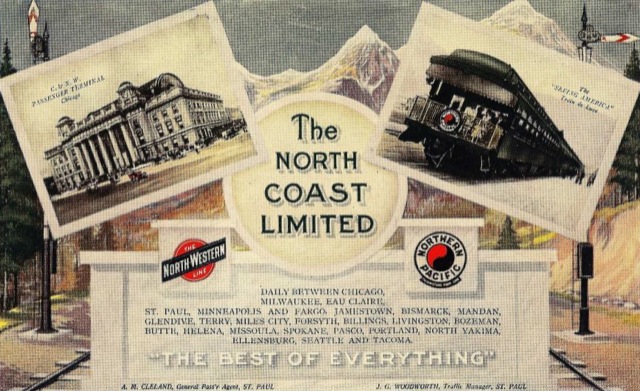
Click image to see a larger view of this 1911 postcard.
When NP began operating the North Coast Limited in 1900, it was a Seattle-St. Paul train. Passengers from or continuing east of the Twin Cities had to change trains in St. Paul, and at that time the St. Paul Road (what is now called the Milwaukee Road) was probably the most popular choice.
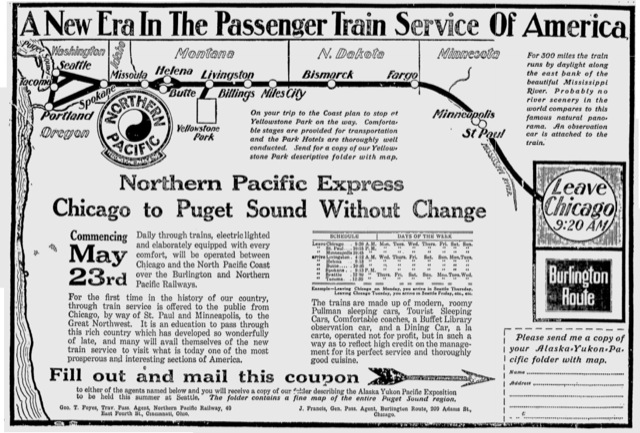
Click image for a larger view of this ad from the Toledo News-Bee of May 18, 1909.
Although NP acquired more than 48 percent of Burlington’s stock in 1901, it was only eight years later that the two railroads advertised that NP passenger trains would run through to Chicago over the Burlington starting May 23, 1909. Instead of the North Coast Limited, the ad above refers to the Northern Pacific Express.
This was one of five transcontinental trains advertised by NP in the 1910 Official Guide. These included the St. Paul-Seattle (via Butte) North Coast Limited, the Chicago-Seattle (via Helena) Northern Pacific Express (which was called the Atlantic Express eastbound), the St. Paul-Seattle (via Helena) Western and Eastern Express, the St. Paul-Seattle (via Butte) Puget Sound/Twin Cities Express, and the St. Louis-Seattle (via CB&Q to Billings then via Butte) Missouri River Express. The North Coast Limited and Northern Pacific Express left St. Paul 12 hours apart, the first at 11 am and the second at 11 pm. The Western Express left St. Paul 1-3/4 hours before the North Coast Limited and arrived in Seattle 1-3/4 after. The Puget Sound Express left St. Paul 45 minutes before the Northern Pacific Express and arrived Seattle 4 hours after.
Note that the ad brags that the Northern Pacific Express is “the first time in the history of our country [that] through train service is offered to the public from Chicago, through St. Paul and Minneapolis, to the Great Northwest.” NP clearly wanted to get the jump on the St. Paul Road, which was then building its own line to Seattle.
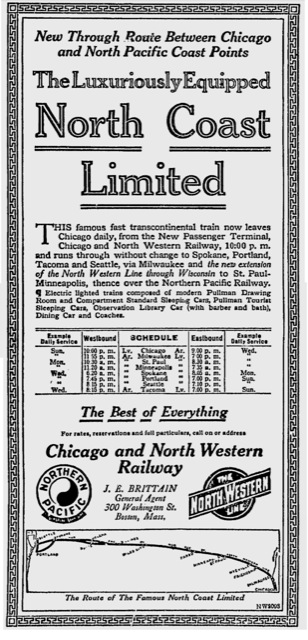 Click image for a larger view of this ad from the Lewiston Evening Journal of December 29, 1911.
Click image for a larger view of this ad from the Lewiston Evening Journal of December 29, 1911.
Just two-and-a-half years later, Northern Pacific announced that the North Coast Limited would go over the rails of the Chicago & North Western to Chicago, commencing December 17, 1911. A couple of things prompted this move.
First, the North Western had just completed the “Adams Cut Off” from Milwaukee to Sparta, Wisconsin, reducing grades and saving 26 miles on the railroad’s Chicago-Twin Cities route. By choosing this route, which was slightly shorter than the Burlington’s route, NP could gain access to Milwaukee passengers that the Burlington by-passed.
More important, the St. Paul Road had completed its Pacific Extension to Seattle, and on May 28, 1911 it began operating two daily Chicago-Seattle trains: the Olympian and Columbian. The new line threatened the NP more than the GN: while the latter railway met the Milwaukee in the Twin Cities, Spokane, and Seattle-Tacoma, the NP also competed with it in Billings, Bozeman, Butte, Missoula, and other points along the route. The NP felt the competition: while GN’s freight revenues grew by 10 percent in 1912, NP’s grew only 1 percent; GN’s passenger revenues grew by 2 percent, but NP’s declined by 11 percent.
The Milwaukee trains “naturally took a considerable portion of the business that they did from the Northern Pacific,” said NP President Howard Elliott in the company’s 1912 annual report. “During the year, arrangements were completed with the Chicago & Northwestern whereby the passenger train known as the North Coast limited, formerly operating between St. Paul and Minneapolis and Puget sound cities and Portland, was run through between Chicago and Pacific coast terminals,” Elliott added. “This arrangement will offset in part the competition of the double daily service of the Chicago, Milwaukee and St. Paul Railway.”
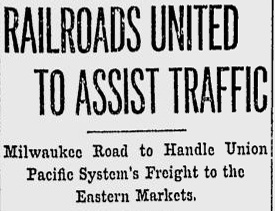
Click image to view this entire article from the May 7, 1912 Milwaukee Sentinel.
The North Western’s capture of the North Coast Limited from the Burlington may have proven costly for the North Western road. Just six months later, Union Pacific announced that it was terminating its exclusive contract with the North Western to carry UP freight east of Omaha and giving the contract to the Milwaukee instead. I can’t find any evidence that NP sent its eastbound freight over the North Western, and there’s no proof that UP was retaliating against the C&NW for cooperating with its Hill rival. But if it was, as many observers thought, then the North Western lost much freight business in exchange for just one passenger train.
In 1918, the U.S. Railroad Administration, which had taken control of the nation’s railroads to expedite traffic during the war, rerouted the North Coast Limited over the Burlington and it remained there until Amtrak. Despite its longer route, the Burlington was easily able to meet the North Western’s (and Milwaukee’s) schedules between Chicago and St. Paul, and Milwaukee’s diminishing importance as a population center apparently reduced the incentive for NP to send its trains over a railroad rival to one that it co-owned. Of course, today Amtrak runs the Empire Builder (and, in the 1970s, the North Coast Hiawatha) over former Milwaukee Road tracks through Milwaukee.
